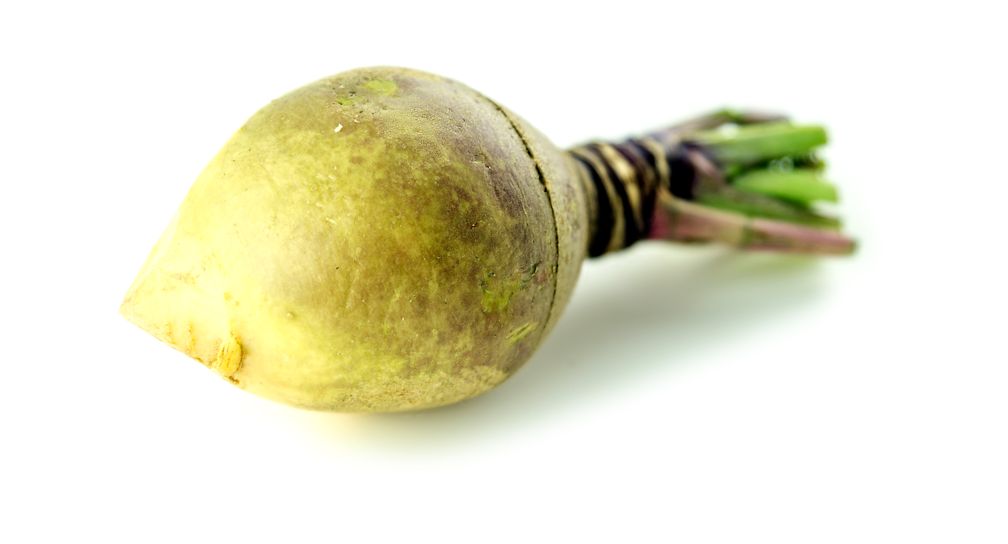Swede
The swede is a forage and vegetable plant known since Antiquity, firstly in Europe and then in North America. Cooked over the centuries with varying degrees of enthusiasm, it is currently back in favour with top chefs because of its sweet, fragrant flavour and colour, which becomes even more vivid after cooking. Its nutritional and medicinal properties are also recognised and valued today.
Swede, rutabaga, brassica napa, Canadian turnip...
The swede has existed since Antiquity. For a long time, the shape of the turnip and the swede distinguished these two members of the cruciferous family. The Roman writer Pliny the Elder talks in his writings of brassica rapa (‘round cabbage’ for the turnip) and brassica napa (‘elongated cabbage’ for the swede).
In the Middle Ages, the swede, called as such because of its Scandinavian origin, gained its bad reputation from the Scala naturae doctrine which ranked every element of the universe, including food, in a pyramid structure. In this classification, the swede belongs to ‘underground vegetables’ associated with the world of demons.
During the Renaissance, it began to be cultivated across the whole of Europe and, in the 18th century, the Scottish botanist Patrick Miller received a swede plant as a gift from King Gustave III of Sweden. This marked its introduction to Great Britain. Nowadays, it is still associated with haggis, a Scottish speciality.
As rich in vitamin C as the orange, this vegetable was included in the Navy’s basic food supplies. The French explorer Jacques Cartier successfully introduced it to North America in the 16th century. These days, Canada and the states of Washington and Oregon supply the whole of the United States, where it is known as the ‘Canadian turnip’. In Europe, this vegetable was ignored after the Second World War but top chefs are once again using it in their cuisine.
A root vegetable which is easy to grow
The swede is a forage or vegetable plant and is probably the result of a spontaneous cross between kale and the turnip. The tops closely resemble rape and, like rape, it belongs to the cruciferous family. It prefers climates which are temperate, moist, even maritime, and direct sunlight. Although it practically emerges from the soil, this tuberous strain of vegetable is nevertheless called a root vegetable. A high-yielding plant, it can be grown at altitude and is frost-resistant. The swede is larger and has a higher nutritional value than its cousin, the turnip, with which it is often confused. It has a sweet flavour with a delicate nutty taste. Its flesh is usually yellow and, unlike other vegetables, its colour becomes even brighter upon cooking. It has a pink, purplish or green neck, depending on the variety.
All styles of swede
Swede can be prepared in a number of ways. It can be eaten raw, boiled or steamed, roasted, grilled and even fried. It can be bought with its tops, or leaves, which can be prepared like young spinach shoots. Over time it becomes stringy, hollow and spongy. It is very often used in stews and also goes well with eggs, cinnamon, nutmeg and truffles.
Today, top restaurants are putting this largely forgotten vegetable back on the menu because of its wonderful yellow colour and its sweet, highly fragrant flavour. In Scotland, it is used as an accompaniment to haggis (stuffed sheep’s stomach).
Nutrition
The diuretic and digestive properties of swede have been recognised since Antiquity. It is low in calories, but rich in potassium, fibre and carbohydrates. It has two interesting characteristics: its high vitamin C content, which remains almost totally intact upon cooking, and its magnesium content, which actually increases upon cooking.
A vegetable to please Don Juan
According to The Four Seasons of the House of Cerruti, an 11th century manuscript, swede with fresh herbs and lots of pepper acts as an aphrodisiac for young men who eat it.
Rutabaga, 1997. L’encyclopédie des aliments. p. 51. Paris : Éditions Fontaine. ISBN: 2842700511
DAVIDSON, Alan, 2006. Swede and rutabaga. In : The Oxford Companion to Food. New York: Oxford University Press Inc. pp 772-773. ISBN: 0192806815, 9780192806819.
KIPLE, F. Kenneth et ORNELAS, Kriemhild Conneè, 2000. Rutabaga. In : The Cambridge World History of FOOD. Volume 2. p.1845. Cambridge : Press Syndicate of the University of Cambridge. ISBN: 0521402158.
PASSARD, Alain et DELVAUX, Catherine, 2012. Le meilleur du Potager. Paris : Éditions Larousse. ISBN : 9782035864147.
RENAUD, Victor, 2003. Chou-navet, rutabaga. In : Tous les légumes courants, rares ou méconnus, cultivables sous nos climats. p. 50. Paris : Éditions Eugen Ulmer. ISBN : 2841382060.
SPENCER, Judith, 1984. The Four Seasons of the House of Cerruti. New York : Bicester, Facts on File Publ. ISBN: 0816001383.
TRONICKOVA, Eva, traduction FAURE, Barbora, 1986. Plantes potagères. Paris : Gründ. ISBN : 2700018133.





